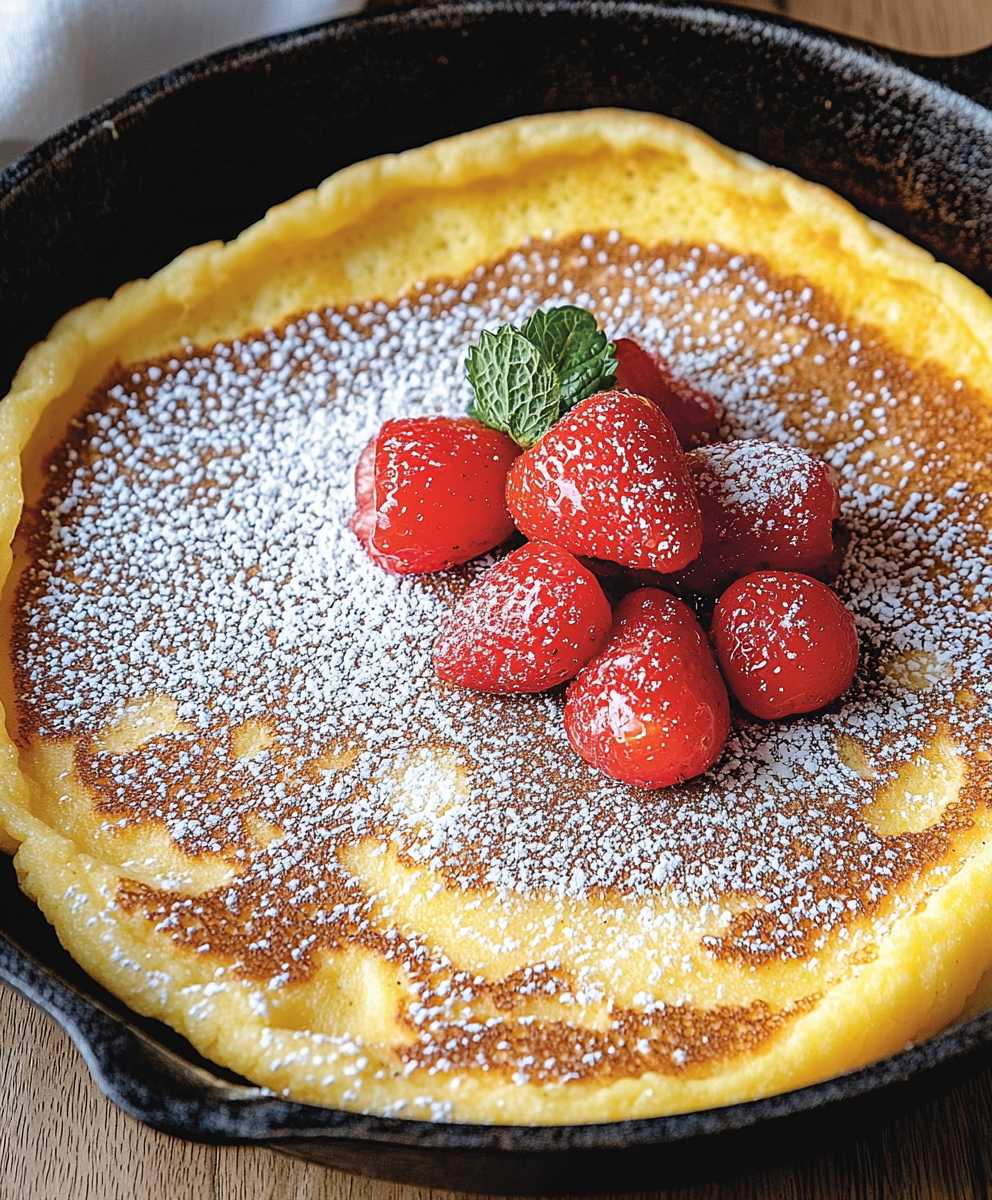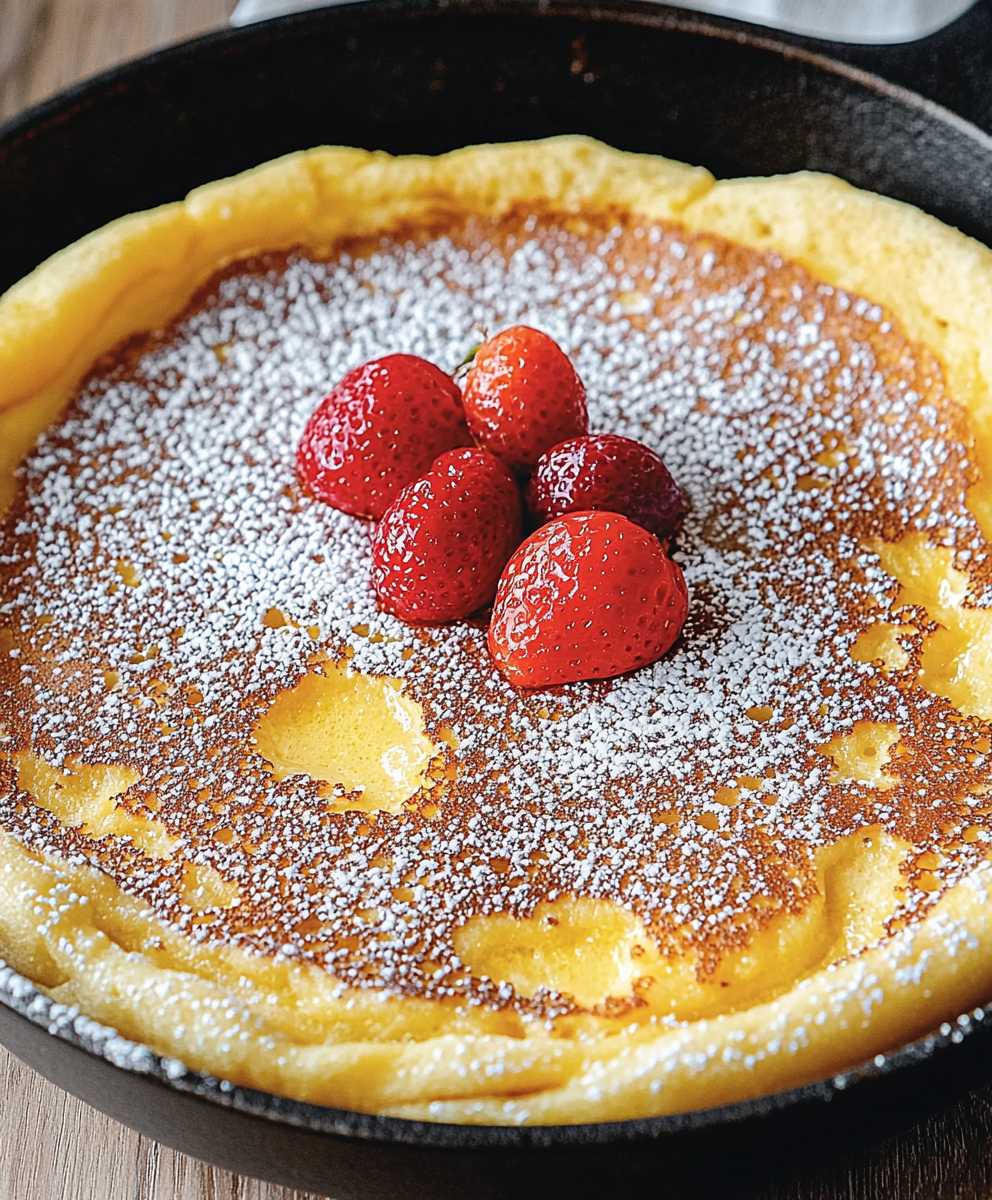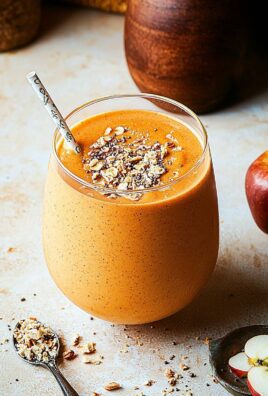German Dutch Baby Pancakes, also known as a Bismarck or a Dutch puff, are a show-stopping breakfast or brunch that’s surprisingly simple to make. Imagine pulling a golden-brown, puffy pancake from the oven, its edges dramatically reaching for the sky, the center a custardy dream just waiting to be adorned with your favorite toppings. It’s a dish that brings a touch of elegance and “wow” factor to any table, and I’m so excited to share my foolproof recipe with you!
While the exact origins are debated, the Dutch Baby is believed to have originated in the United States, inspired by German pancakes. Legend has it that a Seattle restaurant owner’s daughter mispronounced “Deutsch” (German) as “Dutch,” and the name stuck! Regardless of its precise history, this oven-baked pancake has become a beloved classic, enjoyed for its unique texture and versatility.
What makes German Dutch Baby Pancakes so irresistible? It’s the delightful contrast between the crispy, almost crepe-like edges and the soft, eggy center. The simple batter, made with pantry staples, comes together in minutes, and the oven does all the work. Plus, it’s a blank canvas for your culinary creativity! Whether you prefer a dusting of powdered sugar and a squeeze of lemon, fresh berries and whipped cream, or even a savory twist with herbs and cheese, the possibilities are endless. Get ready to impress your family and friends with this easy and delicious treat!
Ingredients:
- 1/2 cup (65g) all-purpose flour
- 1/2 cup (120ml) milk, room temperature
- 2 large eggs, room temperature
- 2 tablespoons unsalted butter, divided
- 1 tablespoon granulated sugar
- 1/4 teaspoon salt
- 1/2 teaspoon vanilla extract
- Powdered sugar, for dusting
- Lemon wedges, for serving (optional)
- Fresh fruit (berries, sliced apples, etc.), for serving (optional)
Preparing the Batter:
Okay, let’s get started! The key to a puffy, impressive Dutch Baby is a smooth batter. We want to avoid any lumps, so follow these steps carefully.
- Preheat your oven to 425°F (220°C). This is crucial! A hot oven is what gives the Dutch Baby its signature rise. Make sure your oven is fully preheated before you even think about putting the batter in.
- Melt 1 tablespoon of butter in your oven-safe skillet. While the oven is preheating, place your 10-inch oven-safe skillet (cast iron is ideal, but any oven-safe skillet will work) in the oven with 1 tablespoon of butter. This will melt the butter and heat the skillet, which is another key to a good rise. The butter should be sizzling when you pour in the batter. Be extremely careful when removing the hot skillet from the oven! Use oven mitts!
- Combine dry ingredients. In a medium bowl, whisk together the flour, sugar, and salt. This ensures that the salt and sugar are evenly distributed throughout the flour, which is important for both flavor and texture.
- Whisk in the milk and eggs. In a separate bowl, whisk together the milk and eggs until well combined. You want a smooth, homogenous mixture. Don’t over-whisk at this stage, just make sure everything is nicely incorporated.
- Gradually add the wet ingredients to the dry ingredients. Slowly pour the milk and egg mixture into the bowl with the flour mixture, whisking constantly until just combined. Be careful not to overmix! Overmixing can develop the gluten in the flour, which will result in a tougher Dutch Baby. A few small lumps are okay, but you want to avoid large clumps of flour.
- Stir in the vanilla extract. Add the vanilla extract to the batter and stir gently to combine. The vanilla adds a lovely warmth and depth of flavor to the Dutch Baby.
- Let the batter rest (optional, but recommended). For an even smoother batter, let it rest for 15-20 minutes at room temperature. This allows the gluten to relax and the flour to fully absorb the liquid, resulting in a more tender Dutch Baby. If you’re short on time, you can skip this step, but I highly recommend it if you have the time.
Baking the Dutch Baby:
Now for the fun part! Watching the Dutch Baby puff up in the oven is truly magical. Just remember to be patient and don’t open the oven door while it’s baking!
- Carefully remove the hot skillet from the oven. Using oven mitts, carefully remove the hot skillet from the oven. The butter should be melted and sizzling. Be extremely careful, as the skillet will be very hot!
- Add the remaining 1 tablespoon of butter to the skillet. Swirl the melted butter around to coat the bottom and sides of the skillet. This will help prevent the Dutch Baby from sticking and will also add a lovely buttery flavor.
- Pour the batter into the hot skillet. Pour the batter evenly into the hot skillet. The batter should sizzle slightly as it hits the hot butter.
- Bake for 20-25 minutes, or until puffed and golden brown. Place the skillet back in the oven and bake for 20-25 minutes, or until the Dutch Baby is puffed up and golden brown around the edges. The center should still be slightly soft. Do not open the oven door during baking! Opening the oven door can cause the Dutch Baby to deflate.
- Reduce oven temperature (optional). If the edges of the Dutch Baby are browning too quickly, you can reduce the oven temperature to 400°F (200°C) for the last 5-10 minutes of baking.
Serving and Enjoying:
The Dutch Baby is best served immediately, while it’s still warm and puffy. It will deflate slightly as it cools, but it will still be delicious!
- Remove the Dutch Baby from the oven and let it cool slightly. Once the Dutch Baby is done baking, remove it from the oven and let it cool for a few minutes before serving. This will make it easier to handle and prevent you from burning yourself.
- Dust with powdered sugar. Generously dust the Dutch Baby with powdered sugar. This adds a touch of sweetness and makes it look even more appealing.
- Serve with lemon wedges and fresh fruit (optional). Serve the Dutch Baby with lemon wedges and fresh fruit, such as berries, sliced apples, or peaches. The lemon juice adds a bright, tangy flavor that complements the sweetness of the powdered sugar and the richness of the Dutch Baby. The fresh fruit adds a burst of freshness and color.
- Cut into wedges and serve immediately. Cut the Dutch Baby into wedges and serve immediately. It’s best enjoyed while it’s still warm and puffy.
- Enjoy! This is the most important step! Savor every bite of your delicious homemade Dutch Baby. It’s perfect for breakfast, brunch, or even dessert.
Tips for Success:
- Use room temperature ingredients. Room temperature ingredients will combine more easily and result in a smoother batter.
- Don’t overmix the batter. Overmixing can develop the gluten in the flour, which will result in a tougher Dutch Baby.
- Use a hot skillet. A hot skillet is essential for a good rise.
- Don’t open the oven door during baking. Opening the oven door can cause the Dutch Baby to deflate.
- Serve immediately. The Dutch Baby is best served immediately, while it’s still warm and puffy.
Variations:
- Add spices. Add a pinch of cinnamon, nutmeg, or cardamom to the batter for a warm, spiced flavor.
- Add extracts. Experiment with different extracts, such as almond extract or orange extract.
- Add fruit to the batter. Add chopped fruit, such as apples, berries, or peaches, to the batter before baking.
- Top with different sauces. Top with maple syrup, chocolate sauce, or caramel sauce.
- Make it savory. Omit the sugar and vanilla extract and add herbs, such as thyme or rosemary, to the batter. Top with cheese and vegetables.
I hope you enjoy this recipe as much as I do! It’s a guaranteed crowd-pleaser and a fun and impressive dish to make for any occasion. Happy baking!

Conclusion:
And there you have it! These German Dutch Baby Pancakes are truly a must-try for anyone looking to elevate their breakfast or brunch game. The combination of the crispy, puffed edges and the custardy center is simply irresistible. Its a showstopper thats surprisingly easy to make, and I promise it will impress your family and friends.
But why is this recipe a must-try, you ask? Well, beyond the incredible texture and flavor, it’s incredibly versatile. You can customize it to your heart’s content with different toppings and flavor combinations. Think of it as a blank canvas for your culinary creativity!
Serving Suggestions and Variations:
The classic way to serve a German Dutch Baby Pancake is with a dusting of powdered sugar and a squeeze of lemon juice. The tartness of the lemon perfectly complements the richness of the pancake. However, don’t let that limit you!
* Fresh Fruit: Berries (strawberries, blueberries, raspberries), sliced peaches, apples, or even caramelized bananas are fantastic additions.
* Sweet Sauces: Drizzle with maple syrup, honey, chocolate sauce, or a homemade berry compote.
* Savory Options: For a savory twist, try topping it with sautéed mushrooms, spinach, and a sprinkle of Parmesan cheese. You could even add some crumbled bacon or sausage for a heartier meal.
* Spiced Variations: Add a pinch of cinnamon, nutmeg, or cardamom to the batter for a warm and comforting flavor.
* Nutty Goodness: Sprinkle with chopped nuts like almonds, pecans, or walnuts for added texture and flavor.
* Citrus Zest: Add lemon or orange zest to the batter for a bright and zesty flavor.
* Chocolate Chips: Fold in chocolate chips for a decadent treat.
Honestly, the possibilities are endless! Feel free to experiment and find your favorite combination. Ive even tried a version with a dollop of Greek yogurt and a drizzle of agave nectar for a healthier option.
Why This Recipe Stands Out:
What sets this recipe apart is its simplicity and the wow factor it delivers. It requires minimal ingredients and effort, yet it looks and tastes like something you’d order at a fancy brunch spot. Plus, it’s a great way to use up those eggs and milk in your fridge.
The key to a perfectly puffed Dutch Baby is a hot oven and a screaming hot skillet. Don’t be tempted to open the oven door while it’s baking, as this can cause it to deflate. Trust the process, and you’ll be rewarded with a golden-brown masterpiece.
I truly believe that everyone should have this recipe in their repertoire. It’s a crowd-pleaser that’s perfect for any occasion, from a lazy Sunday brunch to a special celebration. And the best part? It’s so easy to make that even beginner cooks can master it.
So, what are you waiting for? Grab your skillet, preheat your oven, and get ready to experience the magic of German Dutch Baby Pancakes. I’m confident that you’ll love this recipe as much as I do.
I’m so excited for you to try this recipe! Once you do, please come back and share your experience in the comments below. Let me know what toppings you used, what variations you tried, and how much your family and friends enjoyed it. I can’t wait to hear all about your Dutch Baby adventures! Happy baking!
German Dutch Baby Pancakes: The Ultimate Guide to Fluffy Perfection
A classic Dutch Baby pancake, baked in a hot skillet until puffed and golden brown. Serve immediately with powdered sugar, lemon wedges, and fresh fruit for a delightful breakfast, brunch, or dessert.
Ingredients
- 1/2 cup (65g) all-purpose flour
- 1/2 cup (120ml) milk, room temperature
- 2 large eggs, room temperature
- 2 tablespoons unsalted butter, divided
- 1 tablespoon granulated sugar
- 1/4 teaspoon salt
- 1/2 teaspoon vanilla extract
- Powdered sugar, for dusting
- Lemon wedges, for serving (optional)
- Fresh fruit (berries, sliced apples, etc.), for serving (optional)
Instructions
- Preheat: Preheat your oven to 425°F (220°C). Place a 10-inch oven-safe skillet (cast iron preferred) in the oven with 1 tablespoon of butter to melt.
- Combine Dry Ingredients: In a medium bowl, whisk together the flour, sugar, and salt.
- Combine Wet Ingredients: In a separate bowl, whisk together the milk and eggs until well combined.
- Combine Wet and Dry: Gradually add the wet ingredients to the dry ingredients, whisking constantly until just combined. Be careful not to overmix.
- Add Vanilla: Stir in the vanilla extract.
- Rest (Optional): Let the batter rest for 15-20 minutes at room temperature for a smoother batter.
- Prepare Skillet: Carefully remove the hot skillet from the oven (using oven mitts!). Add the remaining 1 tablespoon of butter and swirl to coat the bottom and sides.
- Pour Batter: Pour the batter evenly into the hot skillet.
- Bake: Bake for 20-25 minutes, or until puffed and golden brown. Do not open the oven door during baking. If the edges are browning too quickly, reduce the oven temperature to 400°F (200°C) for the last 5-10 minutes.
- Cool Slightly: Remove the Dutch Baby from the oven and let it cool slightly.
- Dust and Serve: Dust with powdered sugar. Serve with lemon wedges and fresh fruit (optional). Cut into wedges and serve immediately.
Notes
- Use room temperature ingredients for a smoother batter.
- Don’t overmix the batter.
- A hot skillet is essential for a good rise.
- Don’t open the oven door during baking.
- Serve immediately for the best texture.
- Variations: Add spices, extracts, fruit to the batter, or top with different sauces. For a savory version, omit sugar and vanilla and add herbs, cheese, and vegetables.




